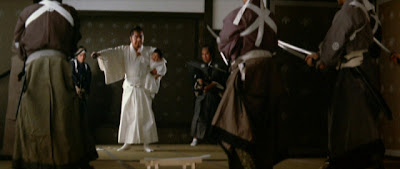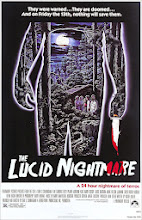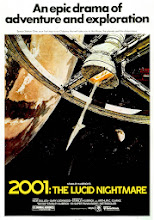Director: Robert Houston & Kenji Misumi
Year 1980
Shogun Assassin is a unique edit of a combination of two better films, but surprisingly the enjoyment that you’ll get out of this hybrid is exceptionally astounding. Comprised of highlights from the first two movies of the Lone Wolf and Cub series, Sword of Vengeance and Babycart at the River Styx, which were both directed by Kenji Misumi, Shogun Assassin is a quick moving revenge story that remarkably sweeps you up into the blood drenched world of an unchained and vengeance-filled samurai. With its epic narrative and pop culture integration, this film manages to rise above the mediocrity of a condensed storyline in order to bring us a vivid retelling of a classic tale, only summarized.
The film follows Ogami Itto, a former decapitator for the Shogun, as he is labeled a demon by his paranoid and senile ruler and then hunted down by every manner of ninja, samurai, and hired hand the Shogun can muster. After the murder of his wife by the hands of the Shogun’s ninja spies, Ogami and his infant son Daigoro set off to avenge the death of his wife by roaming the countryside in search of the fiend responsible. Revenge is a dish best served cold and this violent meal of a flick is frozen to the bloody core.
Tomisaburo Wakayama plays the role of Ogami Itto, the unstoppable Ronin who is so focused on revenge that it threatens to drive him as mad as his quarry. The downward spiral that Ogami takes, which slowly begins to change him into this hate embroiled demon that we see in the majority of the film, is fascinating to see unwind. The character’s concentration and determination to avenge his fallen love is hypnotizing to say the least and
Akihiro Tomikawa takes on the challenging role of Daigoro, the infant son of the Lone Wolf and the only pure thing left in the fallen samurai’s life. For a young actor, Tomikawa does an amazing job of immersing the audience into the character’s innocence and overall helplessness. Some of the moments in this film are cringe worthy, but in a good way, as we see all the near death situations that this child takes on and survives through in the worst of times. The character of Daigoro is integrated into the story line in a number of clever ways, with one of the most obvious being the focal point of many of the attackers’ advances. Daigoro is seen as a weakness for Ogami’s character and the enemies try to capitalize on this notion a number of times, but are quickly and fatally reminded that both Ogami and Daigoro have come to terms with their deaths and have nothing left to fear. Daigoro doesn’t have the benefit of being a big, hulking samurai like his father, so we don’t see that defiance in his character like we do with Ogami, but Tomikawa is able to project his young innocence and determination to aid in his father’s battles and does so in a more subtle capacity. There is one interesting moment where Daigoro is left to his own devices and is forced to find a way to care for his wounded father. The scene is rather moving and the young Tomikawa does an excellent job with the pinnacle moment.
Now let’s get down to the specifications of this re-edited concoction that is Shogun Assassin. The combining of the two full featured films of Sword of Vengeance and Babycart at the River Styx, is something that I would normally shy away from and write off all-together, but the way that this reiteration of these two classic stories is put together enables the overall film to be quite enjoyable. First of all I have to tell you upfront that I was initially introduced to this movie by way of sound clips used in Wu-Tang Clan member GZA’s debut album entitled Liquid Swords. During the intro track of this album, we are given the wonderful narration that is told by the young Daigoro in the beginning of the film and after hearing this amazing run down of sequences from the movie, I knew that I would already be hooked to this cut, even if it is just a summarized version of a more superior entity. Since hearing this intro prior to seeing the film, I felt that I already had a sort of connection with what was behind those words and this in effect allowed me to be more persuasive and open to the English dubbed version’s charm. It also doesn’t hurt that the voice work in this dub is just excellently done. The various characters that inhabit this film are so expressive and intense that it’s hard to separate the original actors’ vocal tracks from this re-edited production that was created a good eight years after its initial release, nor is it possible to ignore the overall atmospheric charge that the synthesized music brings to this re-imagining.
The score for Shogun Assassin is just haunting in an overbearing sense, mirroring the hard trotted journey that both father and son have to travel in order to obtain justice for the death of both wife and mother. With the same collaborative effort of mixing portions of the original film with newly created elements, Mark Lindsay and The Wonderland Philharmonic blend their Moog Modular synthesizer sound with a few select portions of the original soundtrack to make an entirely different feel for the film. With a brooding bass induced tremor of thunderously provocative tones, the soundtrack adds another highlight to the changes that this new edit brings to the table. While never treading on the original’s integrity, Shogun Assassin is a nice alteration to an already accomplished cinematic wonder. In all its Americanized glory, Shogun Assassin does a great job in summarizing the splendid moments of the first two films, while giving us an excruciatingly tantalizing tease on where the original series eventually heads.
The inclusions of both the wonderful vocal work and the ethereal soundtrack are an added bonus and the fact that this film has been sampled by some of the most experimental and poetic minds of the music industry is another example on how far this re-imagined version has traveled on its blood soaked journey for redemption. From the very first time I heard that famous narrative spoken by young Daigoro and accompanied by that haunting synthesized score, I knew that I had experienced something special. It was only till I witnessed the amazing visual work that was established by the films’ original director, Kenji Misumi, which truly validated that initial thought. Here’s to a cinematic gamble that actually paid off. Shogun Assassin is a……
 |
| Don't mess with this man and his baby. |
 |
| And the Worst Father in the World Award goes to..... |
 |
| What a grump! |
 |
| Put the baby down sir! |
 |
| What a beautiful time to lose one's head. |
 |
| Line it up boys. They're just dying to.... well DIE! |
 |
| Look out! It's the baby cart of death! |
 |
| Someone's gonna have a splitting headache in the morning. |
 |
| So what do you think of our kick ass hats? |
 |
| Why couldn't I just have been adopted? |
 |
| Is that a beautiful mirage? |
 |
| Bow down and worship my kick ass hat! |
 |
| Ogami likes to split open heads like watermelons. |
 |
| Get back here you shitheads! |
 |
| Just another day on the job. |
 |
| Hey check it out! There goes my childhood. |
 |
| It's a deadly game of red light, green light. |
 |
| Can you folks at home believe this shit? |






























































































looks like i have to watch this one.
ReplyDeleteman, i love the abundance of screencaps you include in your reviews. keep up the good work.
Thanks glown! I always love it when I catch a review with a good amount of screencaps. It allows me to get a better hold on what the reviewer is writing about, plus I can pretty much gauge if I'm going to love or hate a film just by checking out the visuals that they have on display. I'm glad you're digging the style of the site and I'll keep up the hard work.
ReplyDeleteNice write up Jay! I remember renting this on the old MCA tape and some goof had erased about a minute or so of the movie before realizing they were screwing up a rental, lol.
ReplyDeleteI do prefer the originals, though. I think the BABY CART series spoils viewers on Chambara movies. Most people expect them all to be like this, lol.
Thanks Brian! Yeah I've heard that people are kind of spoiled after watching Shogun Assassin, and they expect the same kind of tone for the rest of the genre, but they are really unique beasts.
ReplyDeleteI haven't had a chance to watch the originals, but I recently received the UK Boxset of all of the films and I'm going to be checking them out real soon. Looks like a blast!